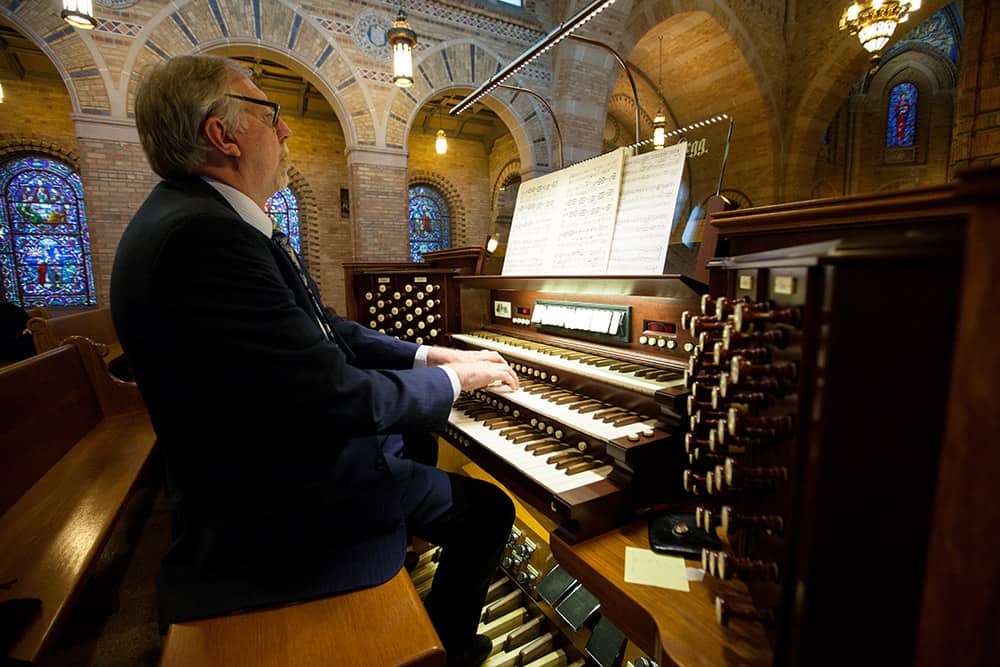If a seminary’s primary role is to form the priests of tomorrow – a divine task – then it’s only fitting that the instrument used for adoration and worship during that formation be equally as divine in nature.
A brand-new pipe organ was installed at St. John Vianney Theological Seminary in January, replacing the electric organ that’s been there for the past 20 years. The organ contains over 1,500 individual pipes that fill Christ the King Chapel with the sounds worthy of an angelic choir and was custom-made by Kegg Pipe Organ Builders based out of Hartsville, Ohio. The organ cost $500,000 to build and was funded entirely by private donors.
The electric organ was in dire need of replacement after a dead squirrel was discovered in its components and was causing all sorts of malfunctions.
Pipe organs are a much more practical instrument to have than an electric organ, said Mark Lawlor, associate professor at St. John Vianney. Pipe organs last at least 100 years as opposed to the typical 20-year lifespan of an electric organ.
“We’d be buying four electric organs for [what will last 100 years],” Lawlor said.
More than just practical, there is a distinct difference in the sound produced by a traditional pipe organ versus an electric organ. Electric organ sounds are produced digitally; the pipes on a pipe organ are produced organically with air, similar to the way a human voice speaks, and in the case of the Kegg organ at the seminary, it allows for a wide range of sonic dynamics that allow the faithful to enter into more ardent worship.

“It surrounds you with the sound,” Lawlor said. “But as loud as it can be, it can also be so hush, and so angelically soft.”
In addition to the organ’s principal sound, its console contains a variety of different knobs that enable the player to produce a wide range of sounds that fall within the woodwind family of instruments, from a clarinet to a flute. However, the organ also features a trumpet and a brighter-sounding pontifical trumpet, which Lawlor says he only plays for Archbishop Samuel J. Aquila and Cardinal J. Francis Stafford.
The six-man crew from Kegg built the organ at their workshop in Ohio, then essentially disassembled it, brought it to the seminary and rebuilt it there. They spent two weeks voicing each pipe individually so they all sound even.
It truly is a sight – and sound – to behold.
“It’s custom-made for [Christ the King Chapel], and that’s where the artistry comes in,” Lawlor said. “The master builder was the one who did that. He has great ears, knows what will fit the room and he did it specifically to the men’s voices.”
Christ the King Chapel is utilized many times in the weekly activities of the seminary – from seminarian formation to permanent diaconate formation to various retreats and workshops – which means that the organ is also used a fair amount in any given week.
What’s exciting to me is if you were a priest and graduated from [St. Thomas Seminary] in the 1950s, you will hear some of the same sounds as the guys in 2050, because we’re still using that organ. We’re tying the whole institution together.”
“We use [the organ] three to four times per day,” Lawlor said.
The organ is an integral part not only to the seminary, but also to the Catholic Church as a whole. Along with the voice, the organ is the preferred instrument for liturgical music. The way an organ functions is congruent with how the human voice functions, and they complement each other perfectly, Lawlor said. Plus, where else do you find an organ besides a church?
“You don’t hear the organ anywhere else, and that’s what makes it special,” Lawlor added.
The original St. Thomas Seminary had a pipe organ made by Kilgin that was replaced with the electric organ in 1997, but many of the original pipes were still intact and were used to construct the new organ. This organ contains 900 new pipes constructed by Kegg, while around 600 of the pipes are from the original 1930s Kilgin organ – meaning some of the same sounds from the 1930s are still being echoed throughout the seminary today.
“What’s exciting to me is if you were a priest and graduated from [St. Thomas Seminary] in the 1950s, you will hear some of the same sounds as the guys in 2050, because we’re still using that organ,” Lawlor said. “We’re tying the whole institution together.”




